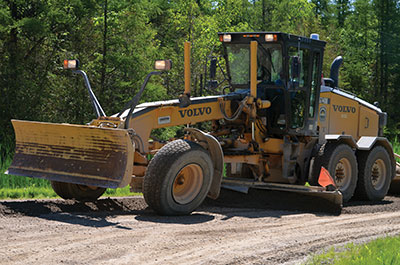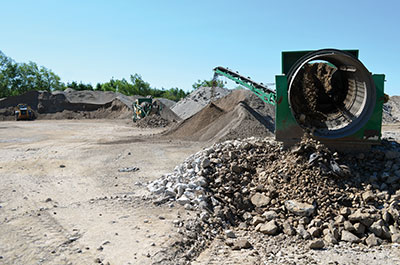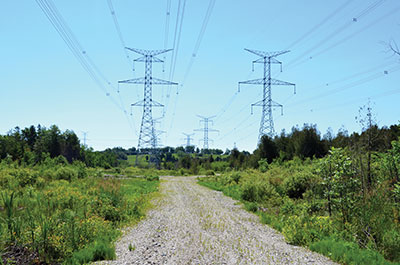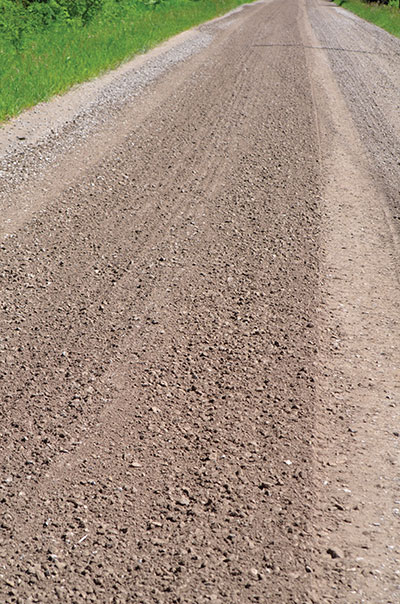
Features
Projects
Roads & Paving
Responsible Recycling
Making the most of free recycled resources
July 31, 2014 By Andrew Macklin
When Larry Van Wyck was told there were thousands of tonnes of recycled
aggregate available which could be delivered for free to a location of
his choice, he jumped at the opportunity to acquire the resource.
When Larry Van Wyck was told there were thousands of tonnes of recycled aggregate available which could be delivered for free to a location of his choice, he jumped at the opportunity to acquire the resource.
 |
|
| The ¾-inch minus materials are used for maintenance gravel on the Township’s extensive gravel road network.
|
Van Wyck, the Road Superintendent for the Township of Erin, located 80km northwest of downtown Toronto, scrambled to find whatever lands he could find to stockpile the recycled gravel. As a result, every square inch of extra space on municipal lands with the Township found itself with a pile of recycled aggregate.
Aggregate resources
The sudden surge of recycled aggregates resources available to the Township of Erin came as a result of an Ontario Hydro project in the region.
Hydro One needed to provide additional power the Greater Toronto Area to meet energy demands in the region. The solution, as Hydro One describes it, was to construct “a new 180-kilometre, double-circuit, 500,000 volt (500 kV) transmission line from the Bruce Power facility in Kincardine to Hydro One’s Milton Switching Station in the Town of Milton.”
 |
|
| In the primary makeshift depot set up by the Township, the recycled aggregate is screened for use on the community’s gravel roads.
|
In order to build the 180km transmission line, millions of tons of aggregate were used to provide the foundations for the towers, stable platforms for the cranes to use to put the towers in place, and access roads for the cement and dump trucks on the project.
However, there was an important stipulation put into the guidelines for the construction project. Within one year of the line actively carrying hydro, the access road for the hydro line had to be removed. As a result, Ontario Hydro had to contract out the removal of all of the aggregate from an approximately 180km road, and find homes for the materials that were removed.
Municipalities along the transmission line were given right of first refusal for the aggregate resources resulting from the road’s removal. The contractor hired to remove the road would truck the material to any location in each municipality, within reason.
“We took all of the material that we could find a home for,” said Van Wyck. “We took some of it directly to a road site: 2 ½ blocks of rebuilt country road using the Hydro One gravel as the road base. The rest was placed at various municipal properties, and some was traded in exchange for services like equipment use.”
The material was a mix of varying size of stone as well as organics, including wood, dirt and geotextile. The original road had been placed on geotextile, and, when the road was removed by the subcontractor using an excavator, the geotextile was part of the material that was received by the municipality.
“We had no control over the product that we received,” said Van Wyck. “A third-party company did the removal work, not Hydro One or the Township.”
As for the aggregate, the stone was primarily 4-inch minus quarried limestone, with some gabian stone mixed as a result of some of the wet, low-lying areas that the transmission ran through.
Van Wyck estimated that, between all three uses of the aggregate provided, the Township took in over 100,000 tonnes of recycled materials.
Processing the product
Once the recycled aggregate was in the handful of municipal depots, the first job for Van Wyck was to bring screening equipment in to process the materials. Initially, Van Wyck brought in a KPI-JCI vibrating screen that took out the fibre cloth and anything passing a one-inch screen. The resulting 1-inch minus material was put on the roads, providing the aggregate needed for resurfacing work.
 |
|
| The remnants of the road, the source of the recycled aggregate, used during the construction of the hydro line.
|
The second time through, the contractor Van Wyck hired used a pair of ¾-inch trommel screens from McCloskey, with three loaders, two John Deere and one Doosan, helping move the stockpiled materials to and from the screens. Any remaining fine material and small stone has also been used for dirt road resurfacing. The pile that remains represents the geotextile cloth, 1-inch plus and oversized organics.
Once the organics and geotextile are removed, Van Wyck plans to hire a contractor to bring in a mobile impact crusher to create on spec granular A to be kept at the remaining stockpile areas for future use as road resurface gravel.
“We have made some 2-inch clear limestone and we have put it in soft spots that occur on our roads in the spring,” says Van Wyck. “We have buried it straight for road base as well, but our primary use will be the road surface gravel.”
So far, the crushed limestone recycled product has worked out very well for the Township, providing a solid alternative to the low-cost aggregate resources previously purchased for use on the community’s roads.
“The gravel bound very well,” says Van Wyck. “It stayed on the road better than the material we have been using. It’s a little bit off MTO spec, as it has a little more dirt in it. But for our purpose, what we have been using it for, it has performed quite admirably.”
Challenging conditions
One of the challenges faced by the community has been the unpredictability of the winter weather. The winters in southern Ontario are usually fairly predictable, freezing temperatures with limited snow and few successive melting periods. But the winter of 2013-14 went against the norm, providing a series of challenges for road supervisors throughout the region. Snowfalls were more frequent, cold temperatures stayed longer, and it delayed maintenance on the community’s roads.
 |
|
| The recycled gravel is being used as maintenance gravel on many community roadways.
|
“We have a rolling topography, a lot of hills,” says Van Wyck. “We end up with washes. Because of the rolling hills, drainage isn’t always the best.”
That has made for a difficult spring from rehabilitating the community’s extensive gravel road network. Approximately 80 per cent of the Township’s entire road network is made up of gravel roads.
“We have in excess of 280km of gravel roads,” says Van Wyck. “We apply road maintenance gravel to each road once every three years, with total quantities ranging from 35,000-45,000 tonnes per year.”
There is a portion of the gravel road network that has never been reconstructed, which can also lead to soft spots in the spring. Aggregate has to be brought in to try and bridge the soft spots in order to give people access to their homes. The binding properties of the recycled quarried limestone has made that process a little easier, expecting that the material could stay in place longer than it has previously.
Van Wyck's team have been dumping truck loads of the recycled limestone on roadways throughout the Township to use for maintenance gravel. The Township has three graders in use: one Champion, one Volvo and one John Deere.
The three graders worked on two different job sites on the day that Rock to Road visited the Township. The Champion grader was working in one location, spreading a top layer of maintenance gravel.
In the other location, the John Deere and Volvo graders were working alongside a water truck to both spread the gravel and compact it. Both the Deere 870Gp and the Volvo G740B had a roller attachment fastened to the back of the grader, allowing compaction to take place while the maintenance gravel was being spread.
Thus far, the binding properties of the quarried limestone have provided a noticeable difference on the road network, as the material is being graded into the existing roads. The initial applications, as the roads are being graded, show less loose gravel and a more knitted look and feel. And there could be enough recycled aggregate to do one layer on all 280km of dirt roads in the community.
Van Wyck has enough 1-inch minus and ¾-inch minus aggregate to provide the gravel stockpile he needs to meet the rest of his demands for 2014. It is hoped that he can bring in the crushing equipment this summer to turn the remaining stockpile of 1-inch plus material into A gravel in time for the 2015 road construction season.
If that happens, Van Wyck and the Towonship of Erin will face minimal, if any, aggregate costs for maintaining the community's extensive gravel road network next year. With an unpredictable winter hitting the region in a few months, the timely availability of superior aggregate resources could go a long way in providing safe roadways for motorists throughout the Township.
Print this page